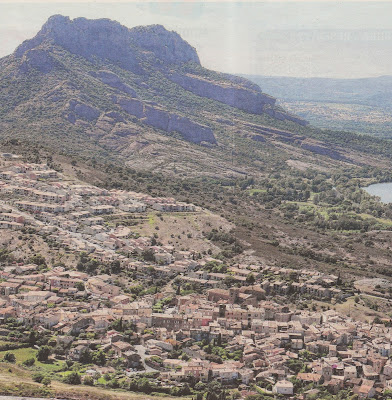 |
| An open-air art exhibition in the main square at Roquebrune-sur-Argens - with the 'rock' in the background. |
In France, there are two ‘Les Arcs’ – one in Provence and
the other, a ski resort in the French alps.
‘Our’ Les Arcs is distinguished by its location ‘sur Argens’ (on the River Argens), but
it hasn’t prevented some tourists arriving at the station, complete with skis
and puzzled expressions wondering both where the mountains are and where the
snow is!
Doubling up again is
Roquebrune. There are also two of them – and this time both are in
Provence.
 |
| The town at the bottom of Roquebrune. Courtesy Var Matin. |
I wrote previously about ‘Roquebrune
Cap Martin’, in the Alpes-Maritimes department, its name linked to the adjacent
to Cap Martin to help distinguish it.
The local one is in Var, a 15-minute drive from Les Arcs,
and like Les Arcs, it is also distinguished by its river – being known as Roquebrune-sur-Argens.
The town nestles on the western slopes of the giant red rock
(the origin of 'Roquebrune'), which reminds us so much of the colours of central
Australia.
The rock is visible throughout most of the town, its craggy summit
towering in the background of many photos.
There is a walking track - part of a Grande Randonnée - which takes you steeply up and
around the rock, and offers views over the countryside and to the sea. I have never walked it – one day, perhaps.
 |
| Street art in the town. |
There is a fantastic market – more of an art market than a
produce market – though you can certainly buy fresh produce here.
Wander through the streets to see wonderful wood carvers,
baskets being made and wool spun before your eyes, beading, book binding, cork
making – fascinating crafts where you can stand and watch the practitioners for
hours.
Many of them are using the traditional methods of work used in medieval times.
 |
| The distinctive wrought iron bell-tower above the clock. |
There are also stands of local produce such as honey, oils, olives, specialty foods.
The ancient centre of the town holds open-air art
exhibitions with works from local artists lining the streets.
Not only that but there is an array of seriously good
restaurants – and I challenge anyone to find a better gazpacho than the one we enjoyed – with a dollop of frozen goat’s
cheese in the centre of the bowl!
There are walks in the wooded hills to the south – up to a
tiny monastery – or you can spend an afternoon at the recreational lake created
in the river just outside the town, where you can fish, canoe, hire a paddle
boat or just laze around on the shady banks.
There might not be the 500 or so steps that distinguish the
‘other’ Roquebrune, but this one
still takes your breath away.